Ethiopia is a country that is blessed with many amazing places to visit, whether you are interested in wildlife, history, landscapes, or archaeology.
We enjoyed a two week tour of Northern Ethiopia, starting in Addis Ababa, then travelling to Barhidar, Gondar, the Simien Mountains, Lalibela, Axum and Gheralta. During this trip, we managed to visit no less than four UNESCO sites. The area around the city of Gondar alone had two.
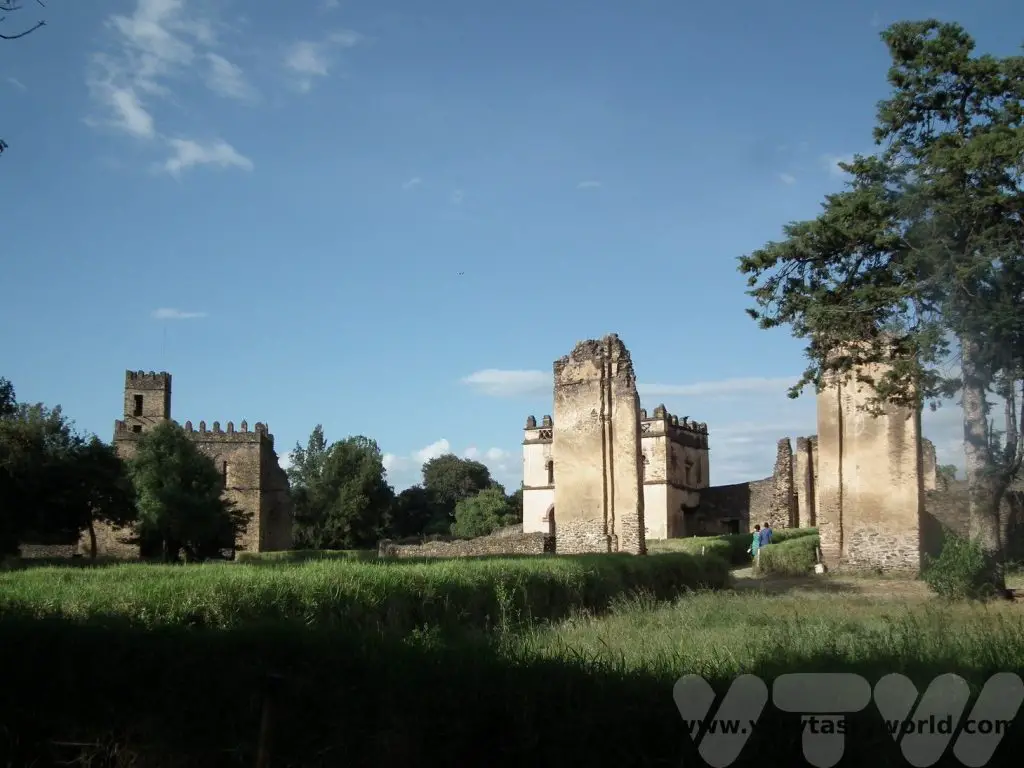
We had travelled to Gondar from Barhidar. We stayed at the Jantekel Hotel, a couple of kilometres from the main attractions. It’s a modern hotel with the most delightful staff.
Ethiopia Gondar City
The city of Gondar was Ethiopia’s capital between 1632 and 1855. Prior to this the country’s leaders had moved throughout the country. It was King Fasil – Fasilides – who decided to settle and he chose Gondar.
There are a couple of legends connected with the reason that Fasilides chose Gondar as his capital. According to one story, Fasilides was out hunting one day when divine intervention led him to encounter a buffalo which showed him the way to the site. Another cited a prophecy which foretold that that the capital of Ethiopia would be a location that began with the letter ‘G’. Whether these are true, Fasilides was content enough with Gondar to establish his government there.
Fasilides was emperor of Ethiopia from 1632 until 1667. He was of the Solomonic dynasty and claimed to have descended from King Solomon and the Queen of Sheba. (Fasilides was also responsible for the building of the Cathedral Church of St Mary of Zion at Axum, which is reputed to contain the Ark of the Covenant.) He built several castles, palaces and churches as well as a long wall, effectively turning it into a fortified city.
We explored many of the remarkable sites at Gondar. We suggest getting a guide who can show you the main sights and explain the history. It’s also worth considering finding transportation because the main sites are a few kilometres apart. We had arranged a guide who could pick us up from our hotel and take us to each location. We recommend a full day sightseeing – it was fascinating and hugely enjoyable.
The Fasil Ghebbi
The Fasil Ghebbi is the Royal Enclosure of the complex built by Fasilides. It comprises a number of buildings that were constructed over the years, the most important of which include Fasilides’ castle, Iyasu I’s palace, Emperor Dawit’s Hall, Emperor Bakaffa’s castle and banqueting hall, Empress Mentewab’s castle, an archive, a library and a number of churches. The word ‘ghebbi’ means ‘enclosure’ so the site is surrounded by an extensive wall. It is possible to explore all these structures that have survived the centuries and there are no restrictions about entering the buildings.
What’s interesting about the construction of these castles is that they look very European, with some Arabic and Indian influences as well.
Fasilides Castle
Fasilides’ castle (which is sometimes referred to as the Egg Castle due to its domes) is the most impressive of all the structures. It has huge towers with crenelated walls which give it the appearance of a European mediaeval castle. High up in the castle was Fasilides’ prayer room. The view from the watchtower afforded views all around Gondar. It’s even possible to see Lake Tana, Ethiopia’s largest lake, on a clear day.
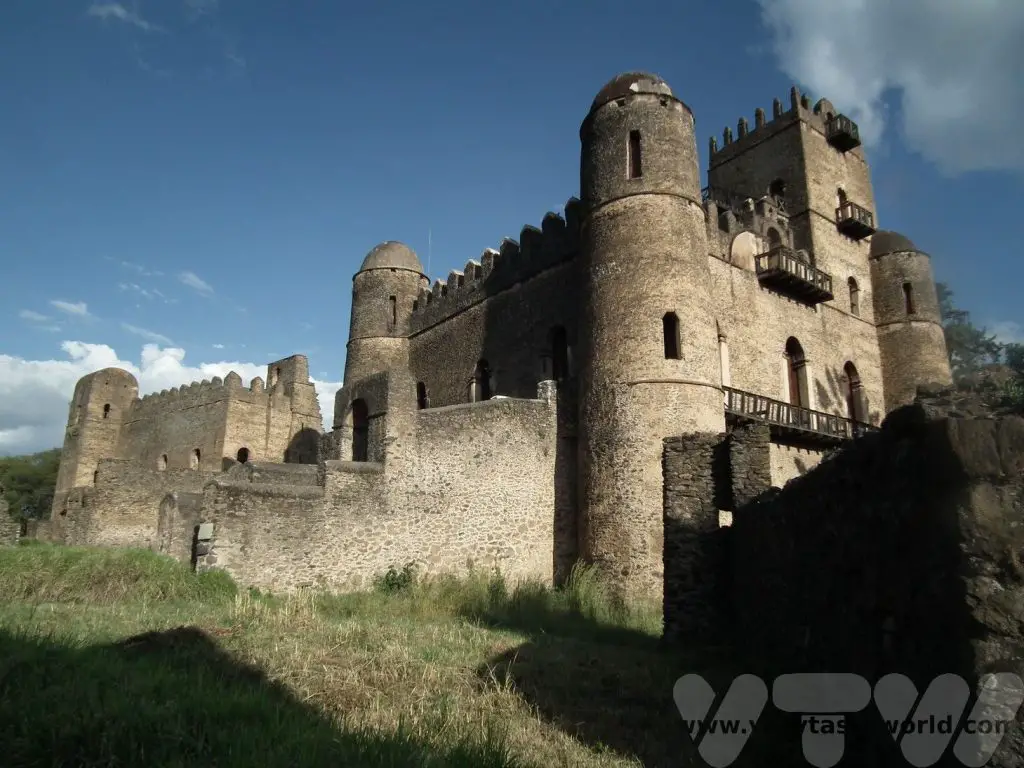
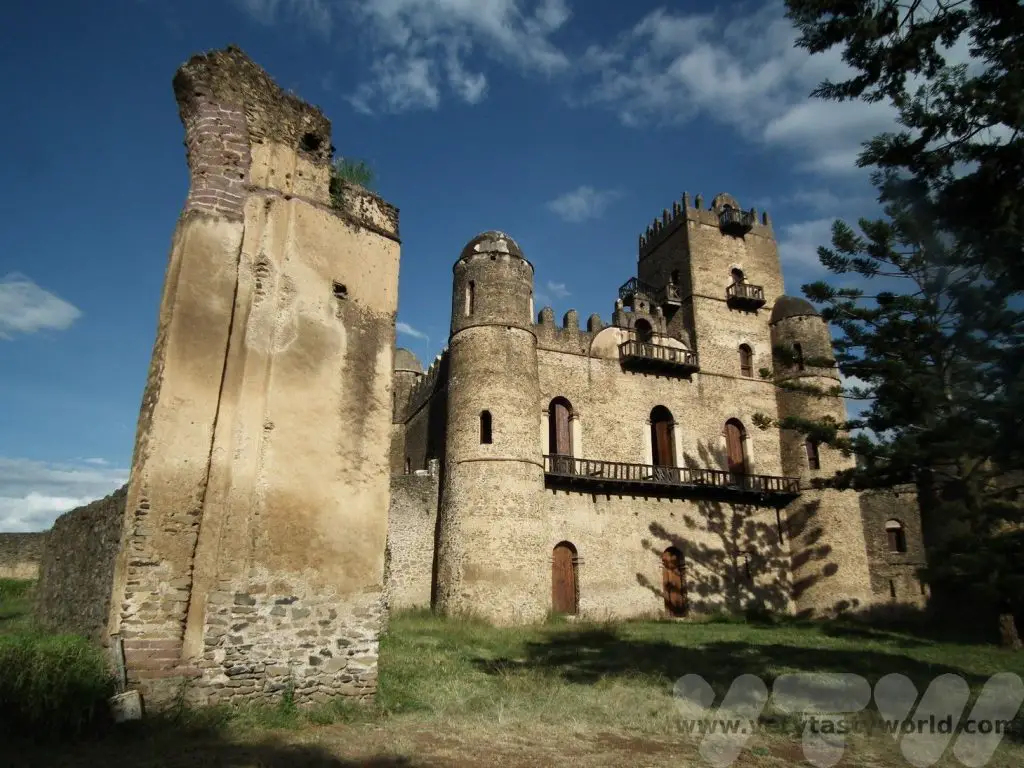
The royal library was built by Emperor Yohannes, Fasilides’ successor.
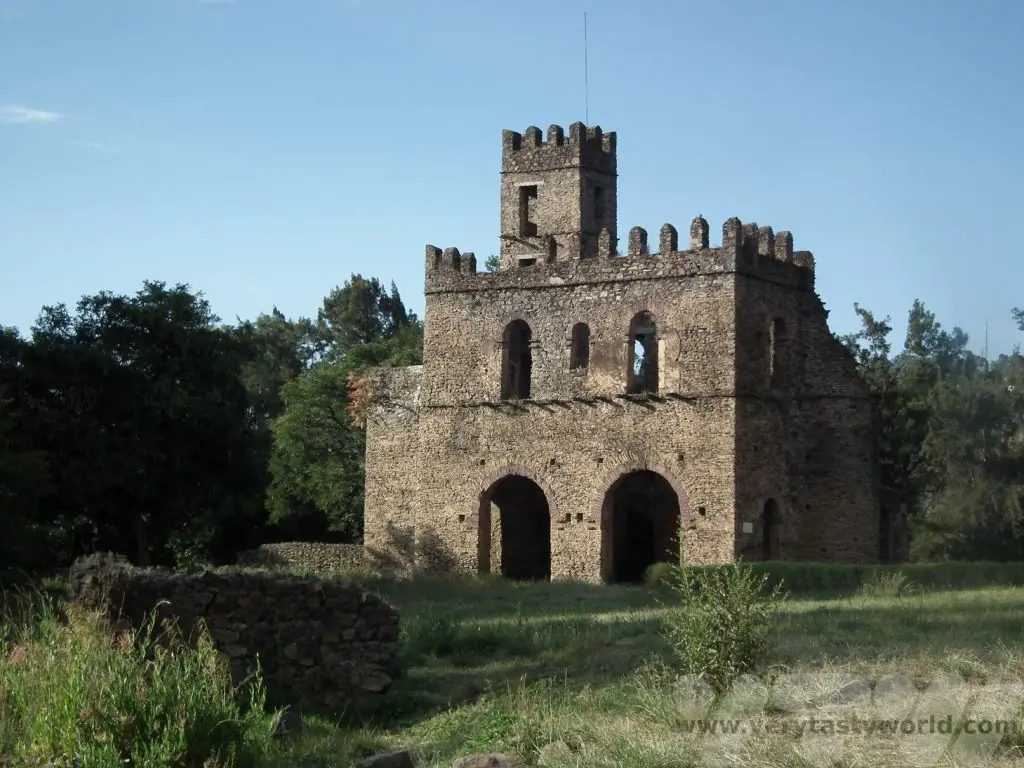
Emperor Iyasu’s palace was apparently the most refined and sumptuous of the buildings with gilded decorations and plush furniture. Iyasu, who ruled from 1682 to 1706, was known as The Great and was the son of Emperor Yohannes I. Although Iyasu led a number of military campaigns he was also known as an emperor who wanted to reconcile religious differences amongst his people, holding councils to discuss and resolve ecumenical matters.
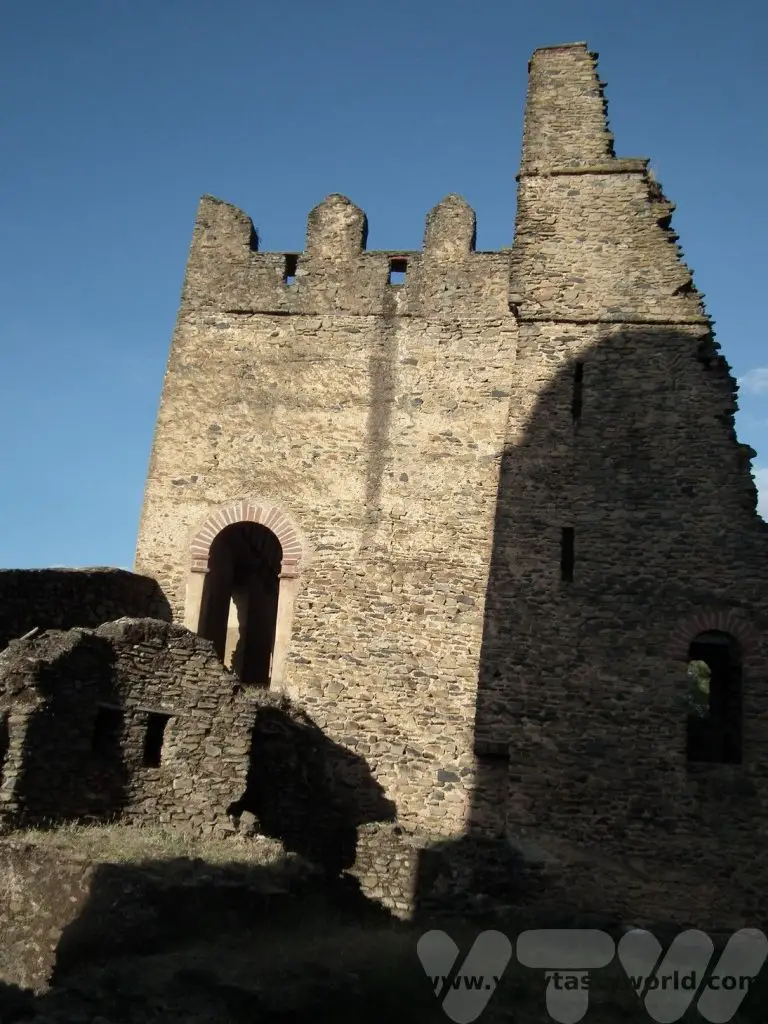
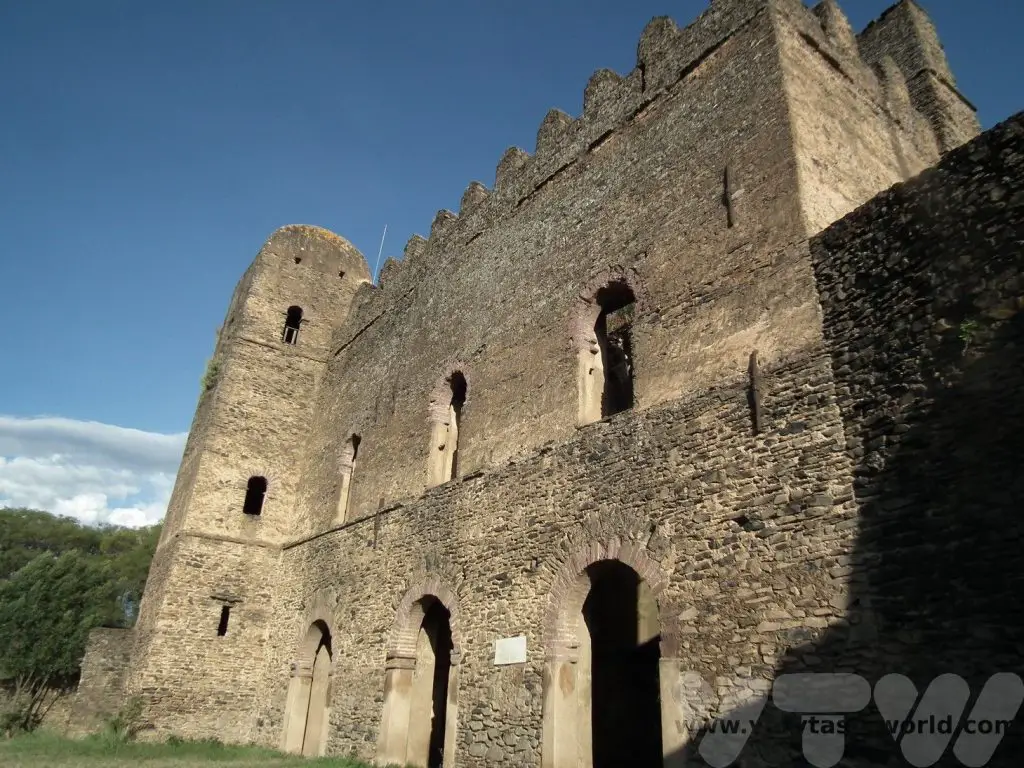
This gateway was accidentally bombed by the British. We were told that they didn’t mean to, they were helping Ethiopia defend itself from the second Italian invasion (1935-37).
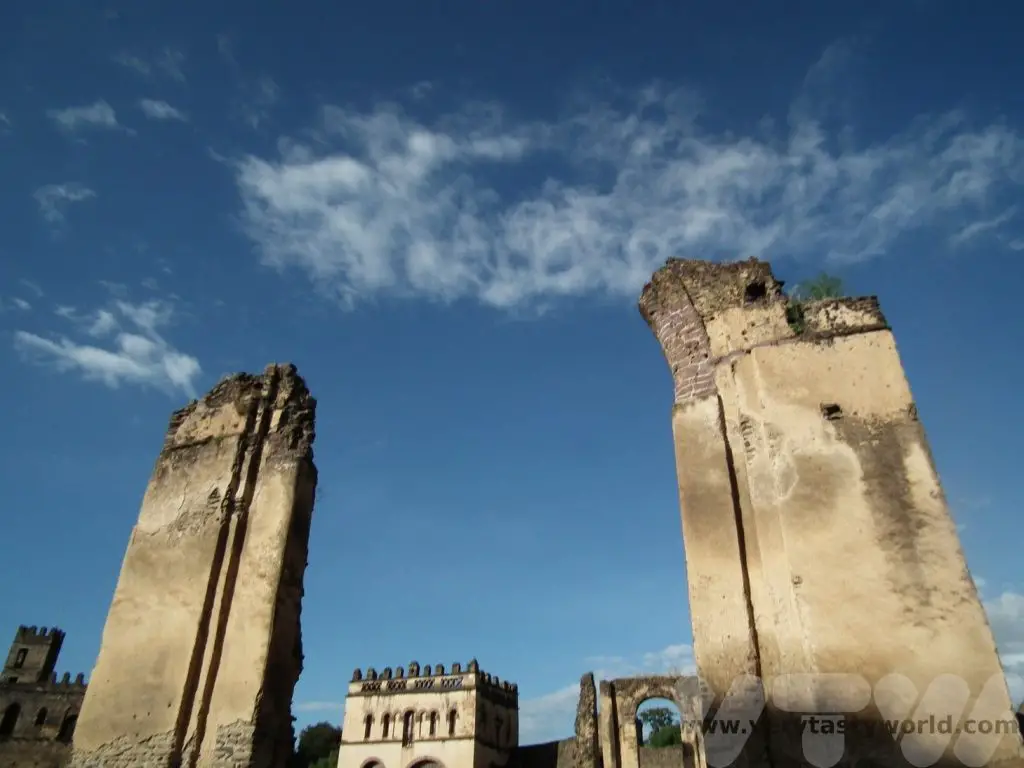
The buildings are largely ruins – very few of the ceilings in the buildings remain, most are destroyed.
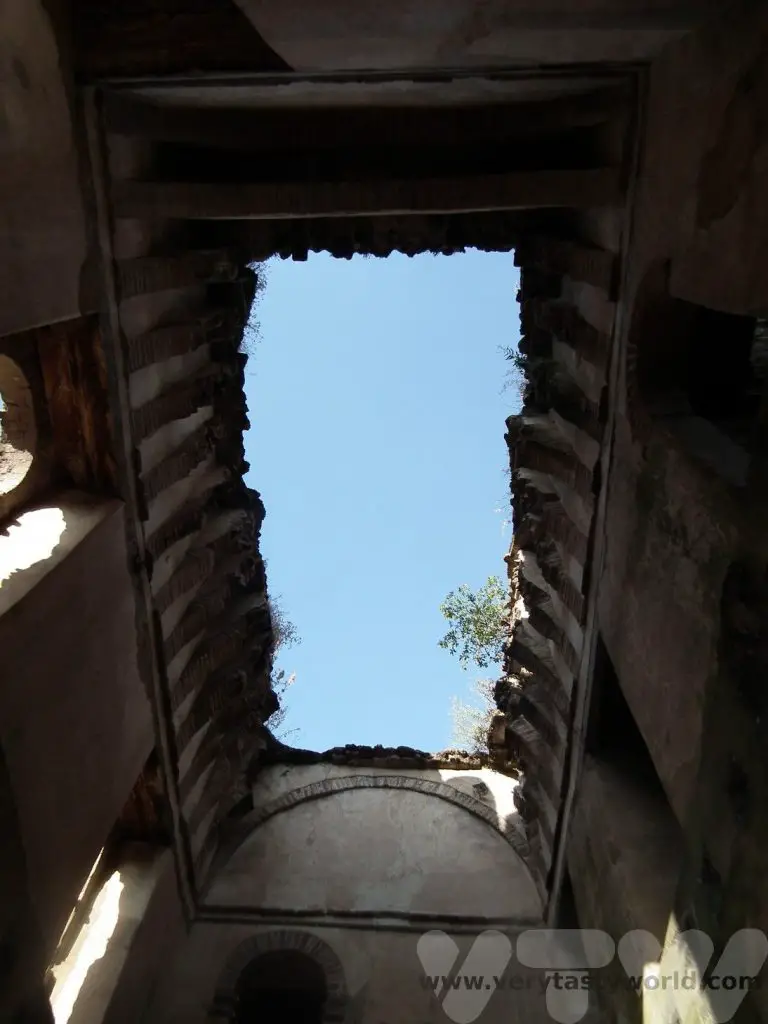
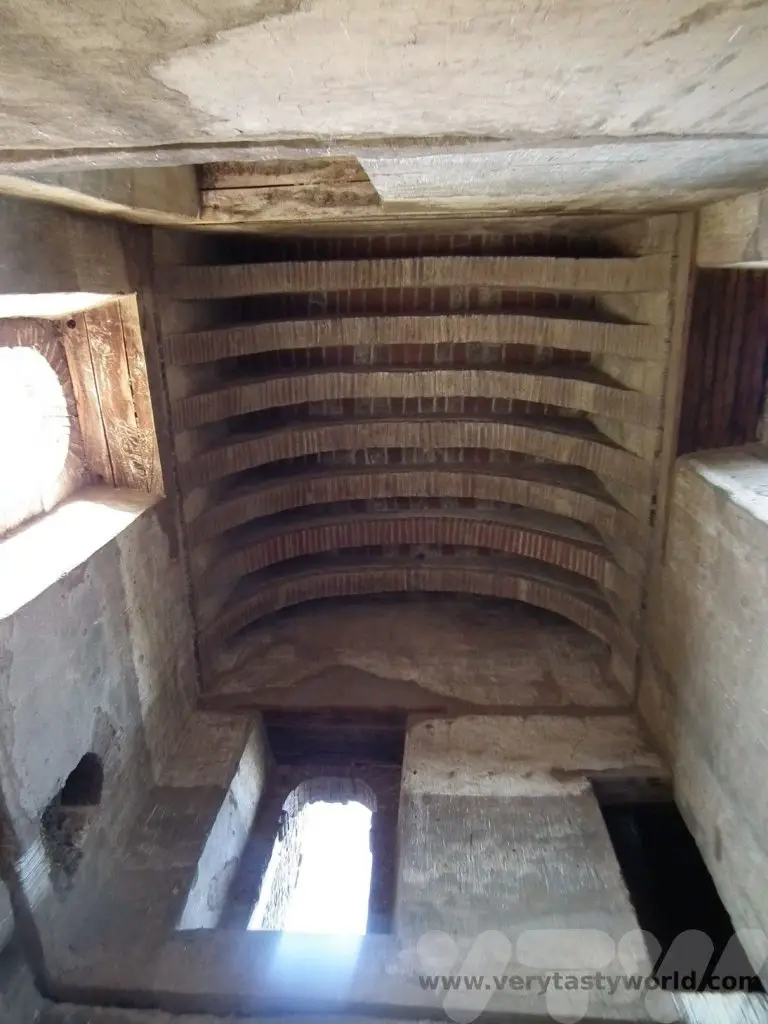
Dawit’s Hall, named for the Emperor Dawit who ruled from 1716 to 1721, was also known as the House of Song, was a place for entertainment and feasting. Unfortunately the feasting came to an end when Dawit met his demise – he was poisoned.
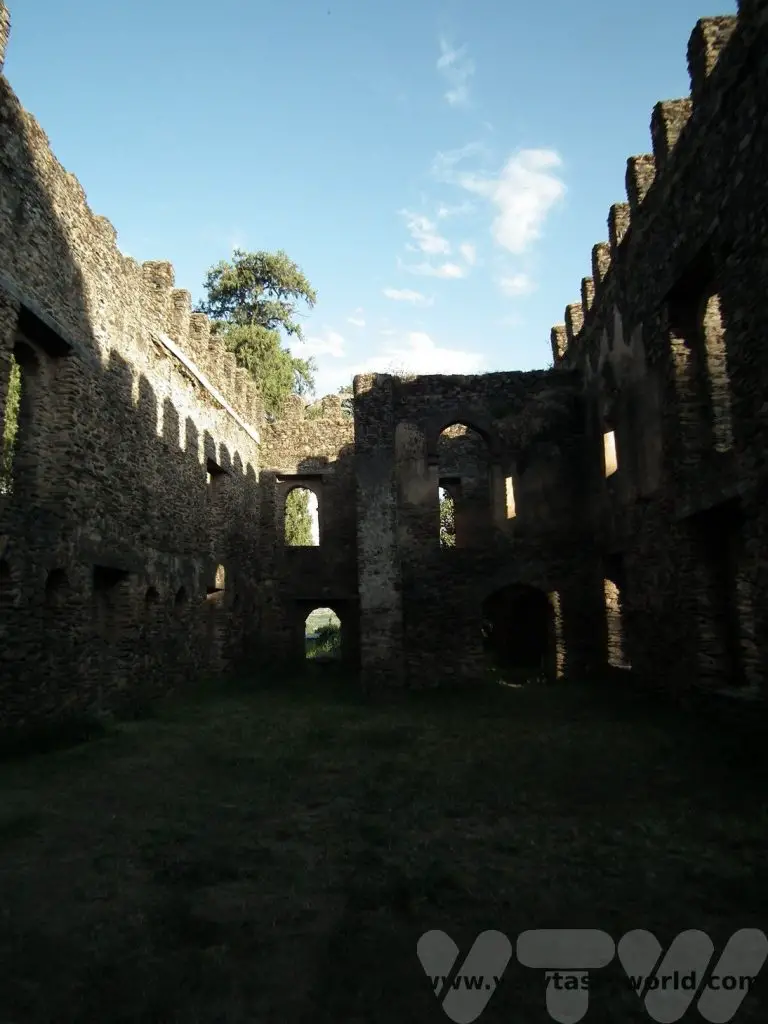
His successor was the Emperor Bakaffa, Dawit’s half-brother, who ruled from 1721 to 1730 (and who married Mentewab, who became a highly influential empress) Bakaffa’s Castle had a huge banqueting hall.
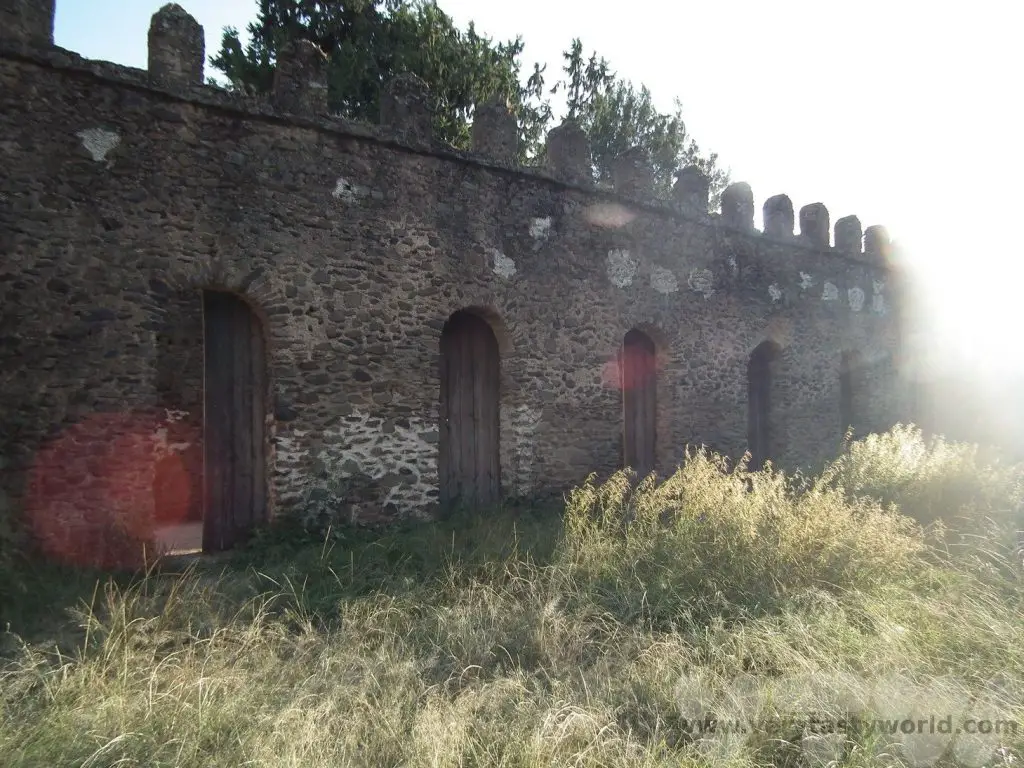
The amazing Zamani project has mapped out 3D models of the main buildings as well as a panoramic view of the site.
Fasilides Baths
A little way out of the city are the Fasilides Baths, a compound thought to be constructed around the same time as the Royal Enclosure. The baths comprise the pool itself, a central tower, and a bridge to the tower which is used when the baths are filled with water.
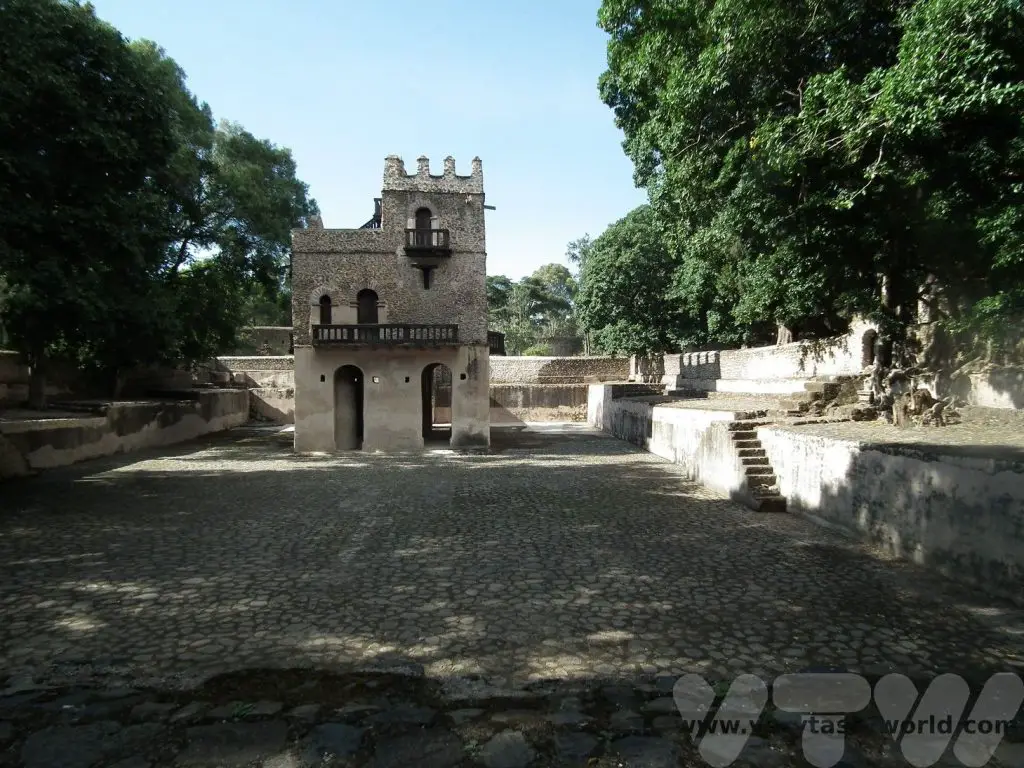
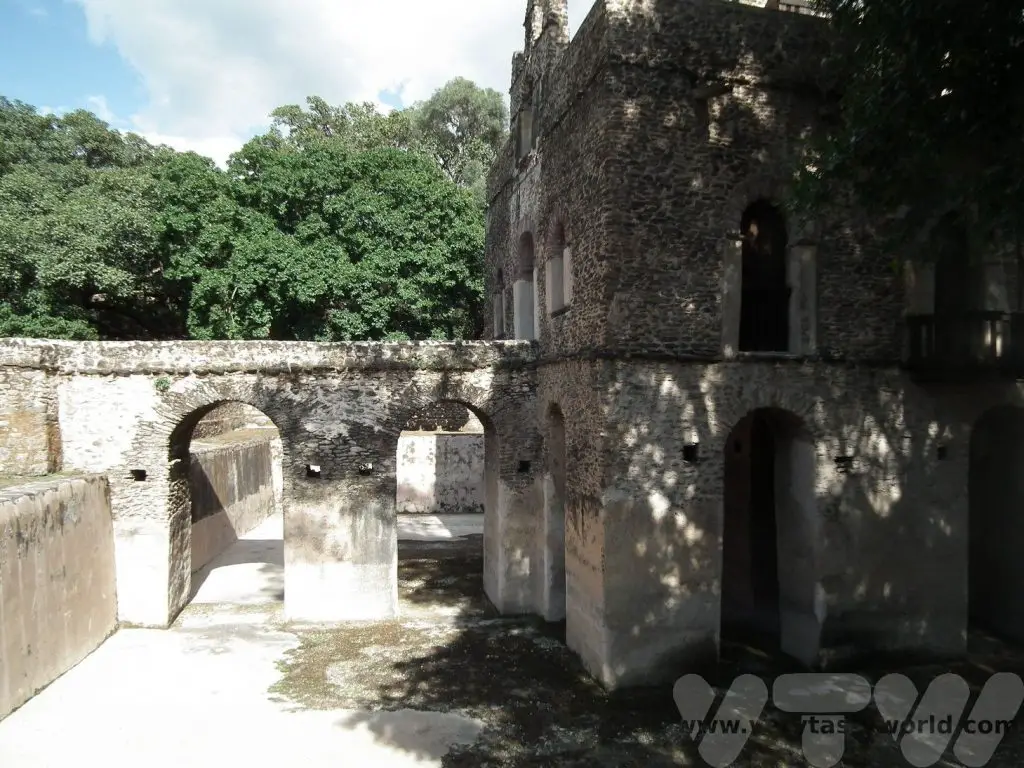
The walls of the baths have slowly been taken over by the local trees.
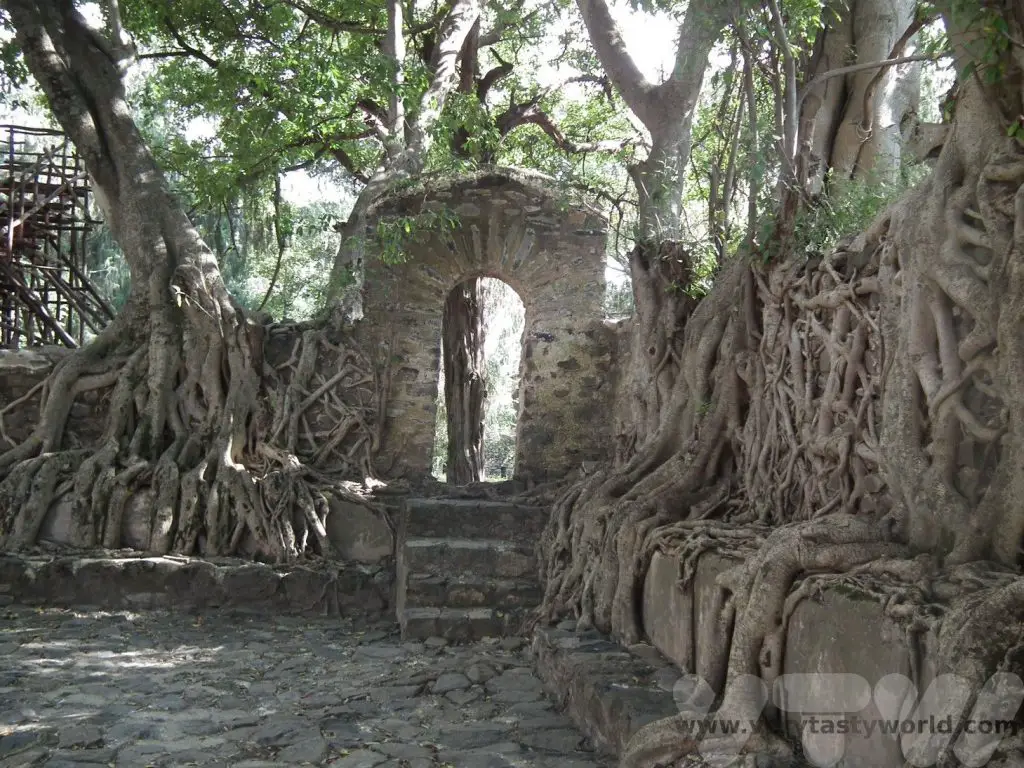
Fasilides baths are considered sacred and are filled just once each year, on the 19th of January, when Ethiopians celebrate Epiphany in a festival known as Timkat. Timkat translates as ‘baptism’ and the festival represents Christ’s baptism by John the Baptist on the River Jordan. It is celebrated across Ethiopia.
Mentewab-Qwesqwam Palace
Mentewab was Empress of Ethiopia from 1722 to 1730. She married Emperor Bakaffa (a son of Iyasu I), becoming his second wife. The first wife died in mysterious circumstances on the day of the wedding banquet, which does seem somewhat suspicious.
After the Emperor’s death, Mentewab was crowned as co-ruler of Ethiopia while her son, Iyasu II, was still a child, and she continued her reign after his murder and when her grandson Iyoas I came to power. She had enormous political influence.
She commissioned several buildings within the Royal Enclosure as well as a church dedicated to St Mary at Qwesqwam, a few kilometres from Gondar. Mentewab also built herself a rather splendid palace next to it, and this became her primary residence and was used as a retreat, away from the Royal Enclosure.
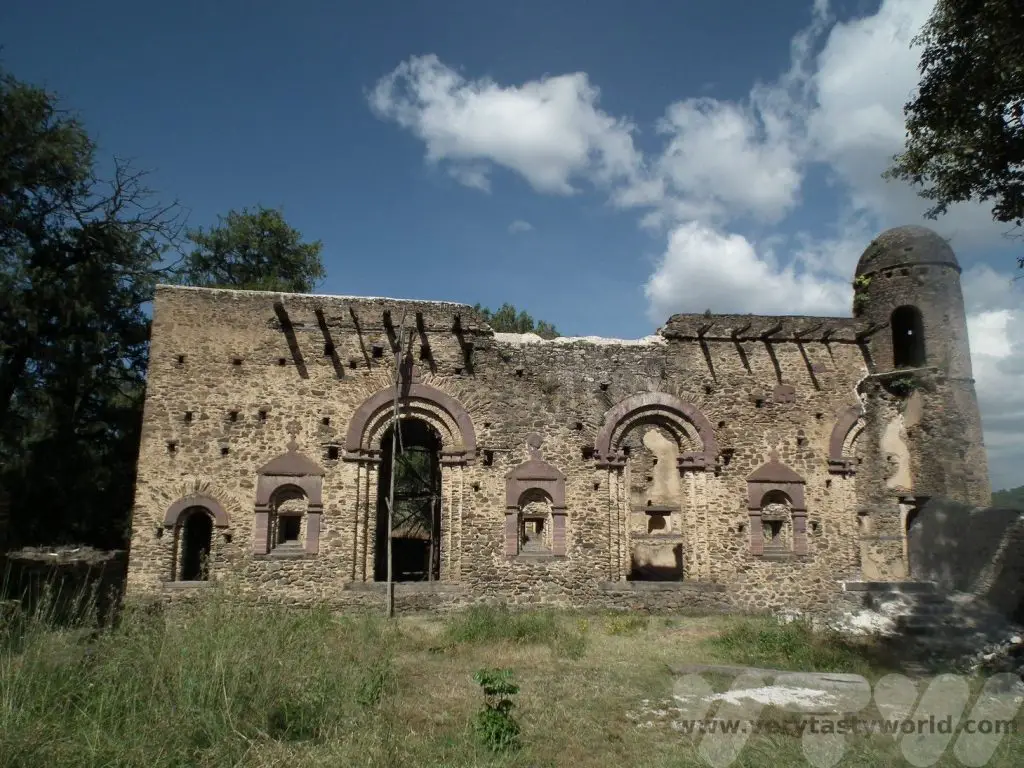
It had an impressive banqueting hall. Mentewab took a lover after Bakaffa died (her husband’s nephew, known as Iyasu the Kept, who was also a grandson of Fasilides) and was exiled because of it. We were told of a legend whereby she invited nobles to visit her palace, then locked them in and wouldn’t allow them out, even to pee. They were eventually released when they correctly answered a riddle. She didn’t have to take any more flak from them after that.
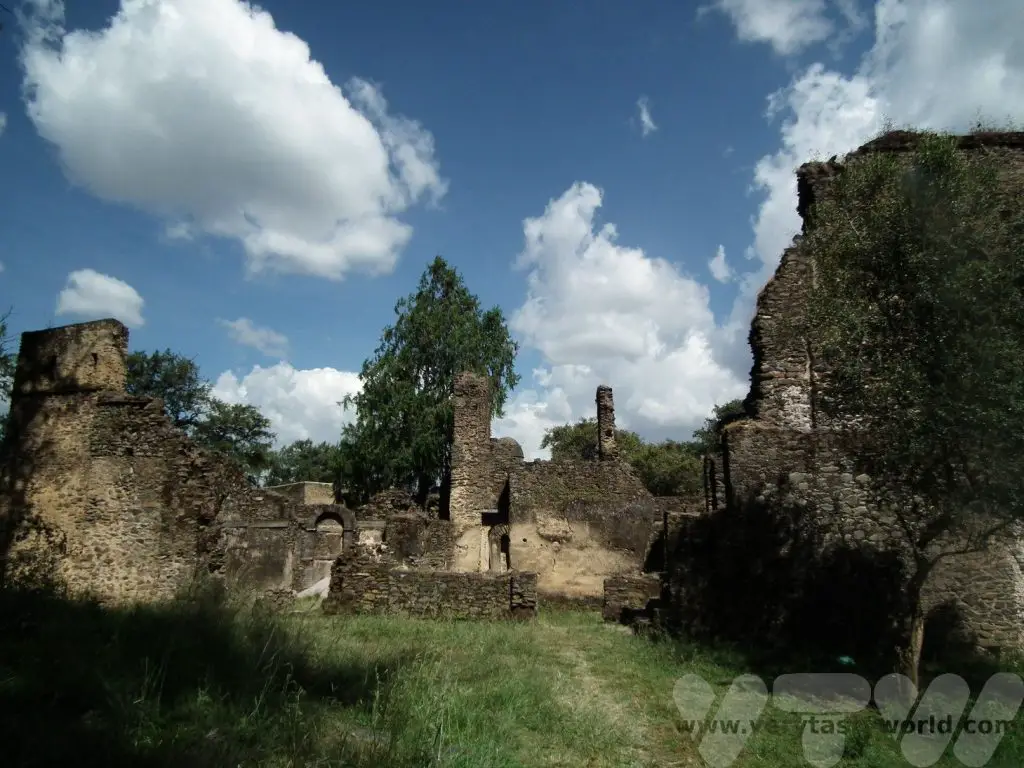
The church and castle were destroyed in a fire in 1888 by Sundanese Mahdists during the sacking of Gondar. Restoration of the church started in the mid-20th century by the Italian occupiers and was completed by Emperor Haile Selassie. The remains of Empress Mentewab, Iyasu II, and Iyoas I, were interred in a glass toppedglass-topped coffin inside the church.
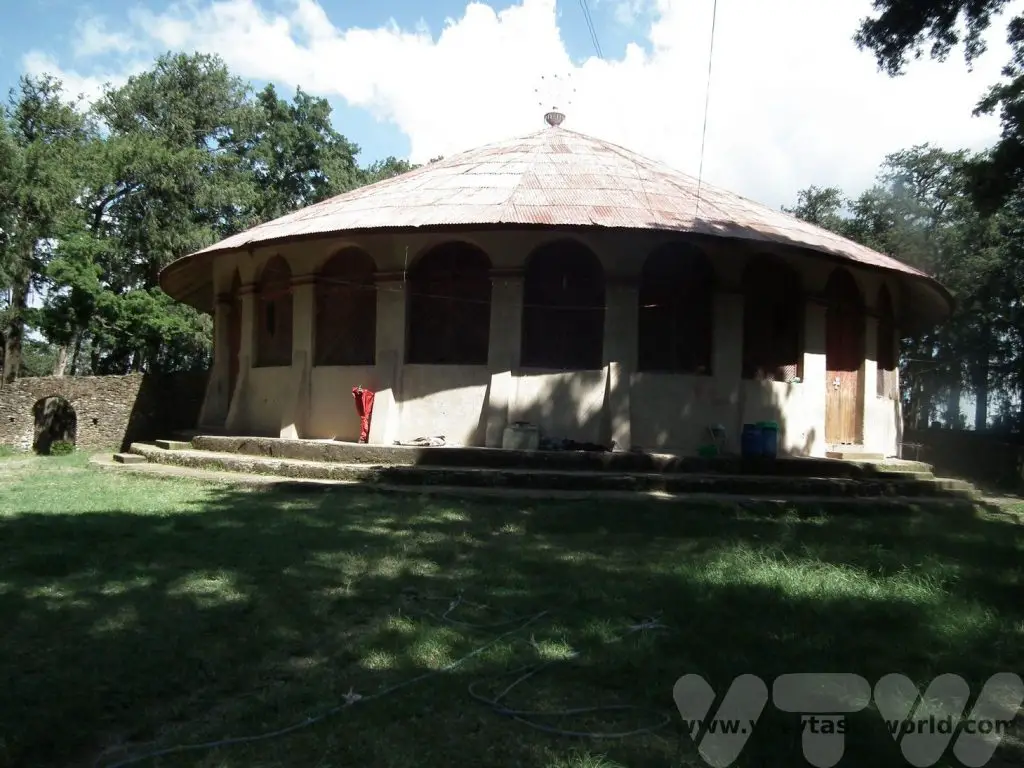
There is also a small treasury at the site where it’s possible to view a centuries-old bible.
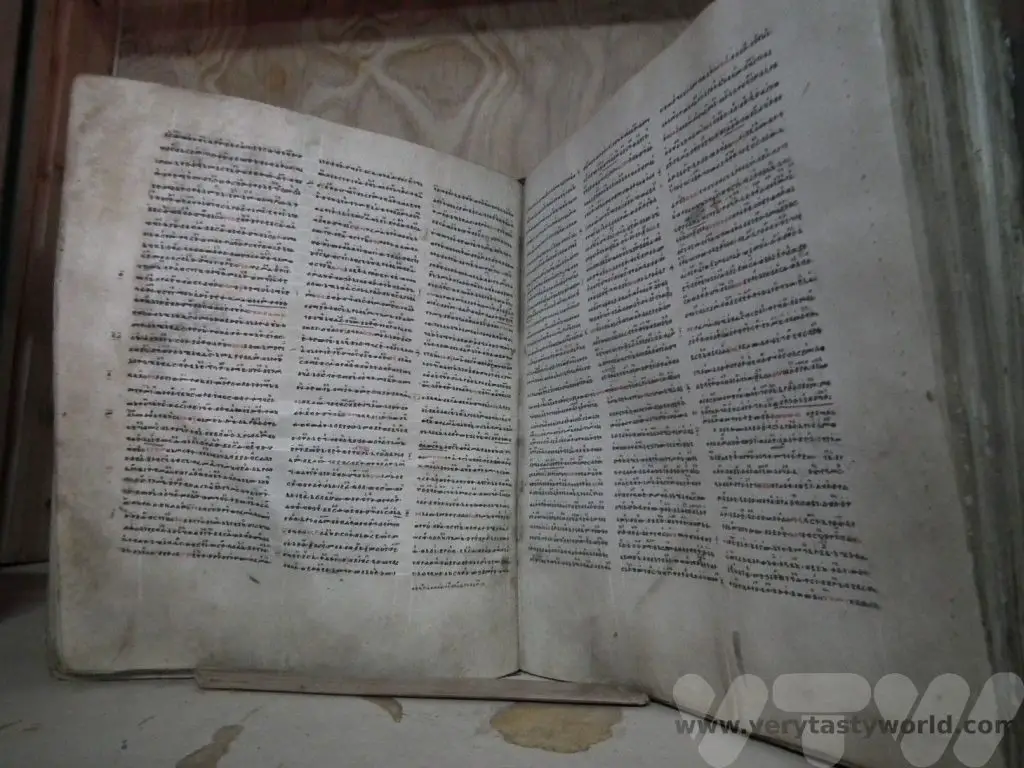
Debre Berhan Selassie Church and Monastery
This is one of the most important of the Ethiopian Orthodox churches. It was built by in the 17th century and its name means ‘Trinity and Mountain of Light.’
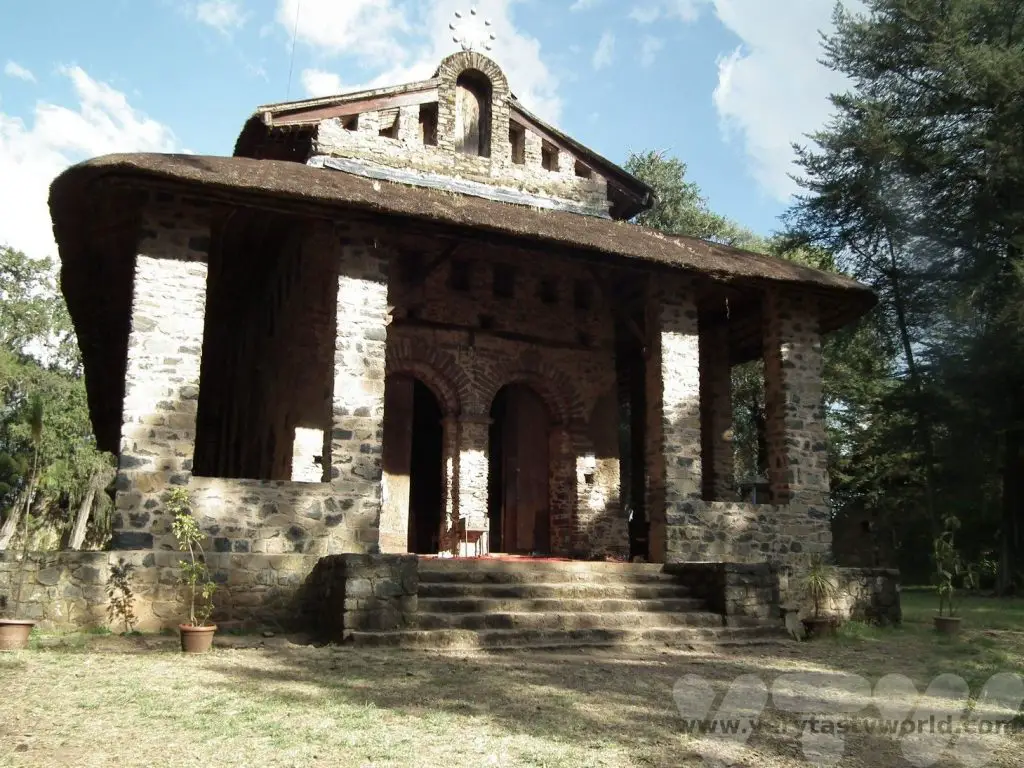
Men and women are allowed to enter, albeit through different doors, and shoes must be removed. Women who are menstruating or have had sex the night before are asked not to enter the church. It’s also requested that conservative clothes and a headscarf are worn.
While the exterior of the church isn’t particularly dramatic or compelling its interior is covered with vivid frescoes depicting tales from the bible.
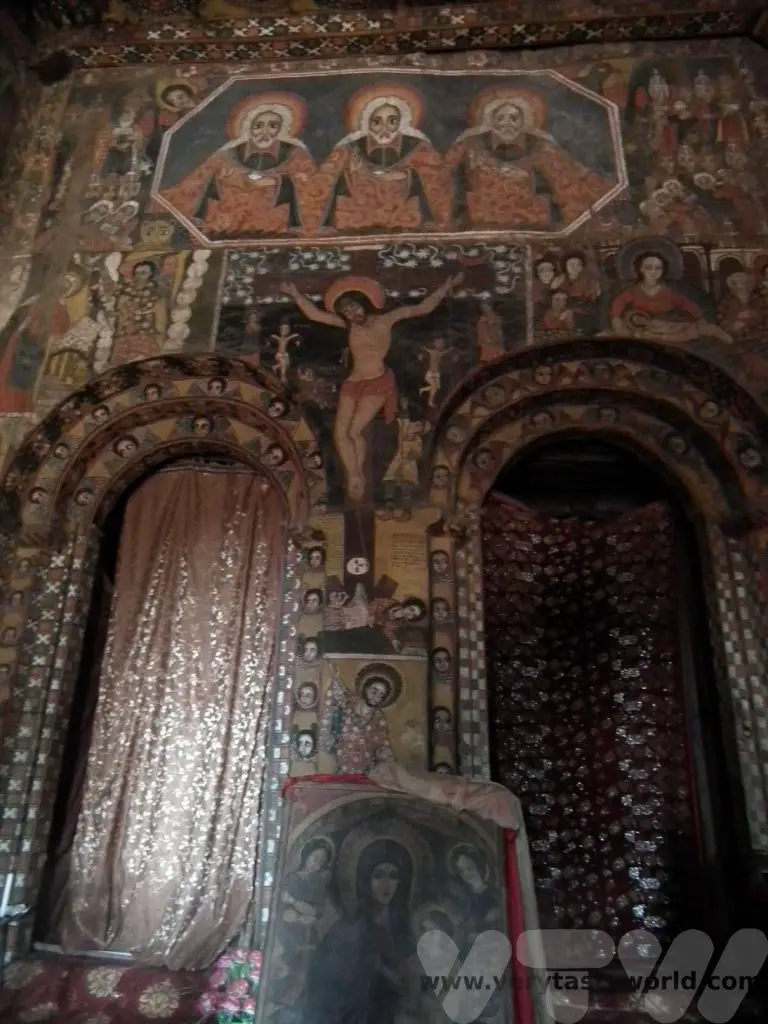
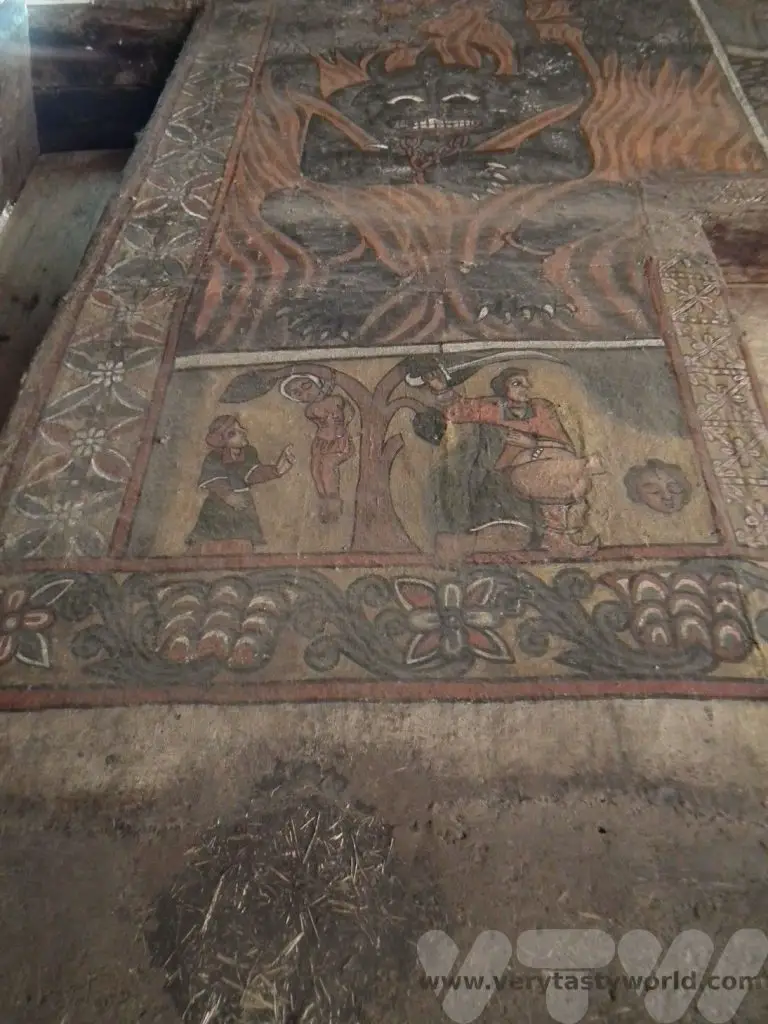
The remarkable ceiling is covered with row upon row of cherubs looking down upon visitors and worshippers. The figures are painted in a style typical of the Ethiopian churches – known as the Gondarine style.
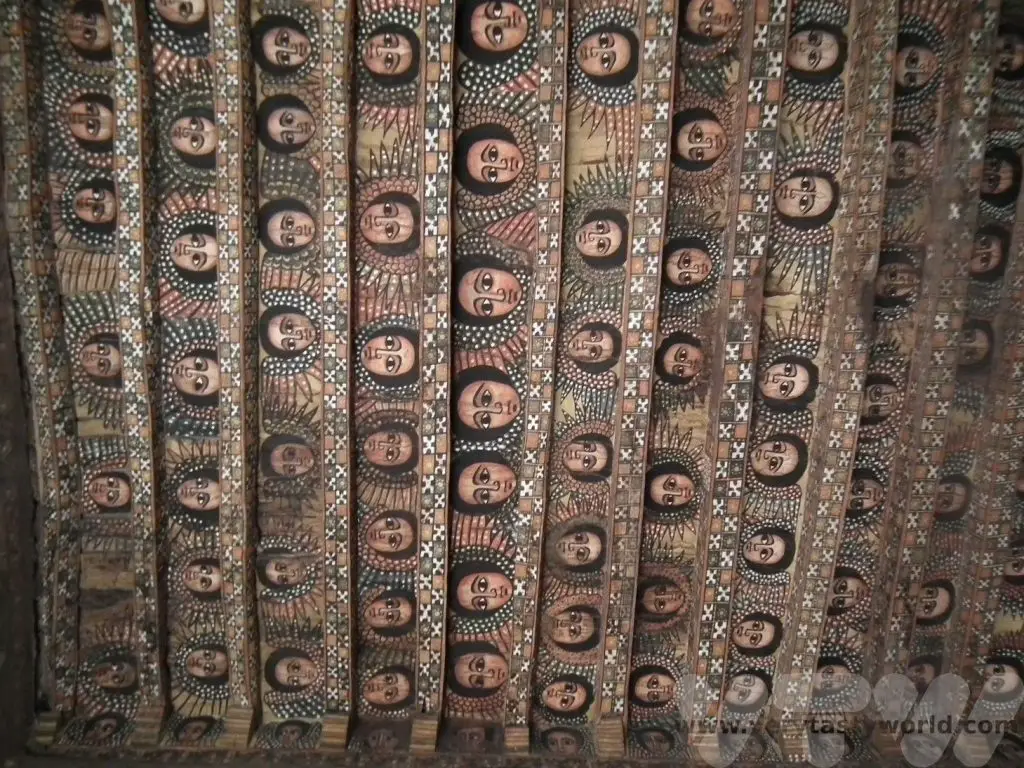
The Simien Mountains
After exploring Gondar’s amazing castles and churches it was time to take a long, bumpy drive to the Simien Mountains. This area is a national park and another UNESCO world heritage site. We drove to The Simien Lodge, via the small town of Debark, situated at an altitude of 3260 meters. The Simien Lodge is the only lodge in the central area of the park. It offered comfortable accommodation in our own private huts.
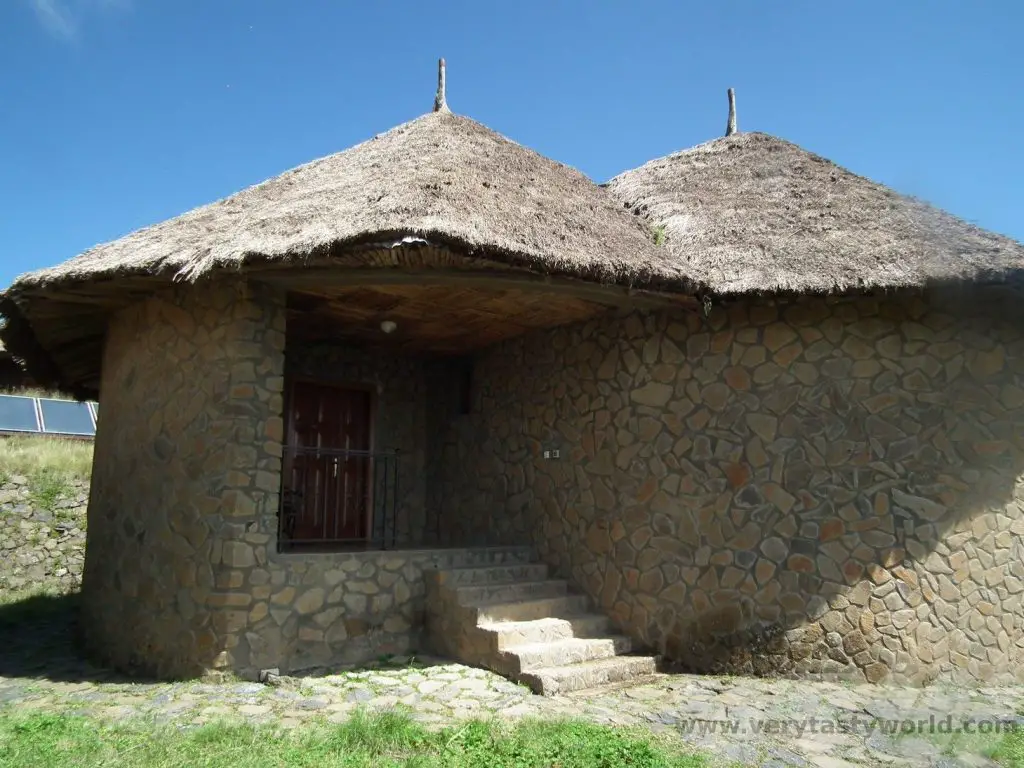
Our only criticism of the place was that meals had to be taken as a buffet (there is no choice to eat anywhere else), which wasn’t a problem per se, but all the food was international – there were no Ethiopian options, which was disappointing. It was also quite pricey but that is understandable as the food has to be brought in from the nearest town.
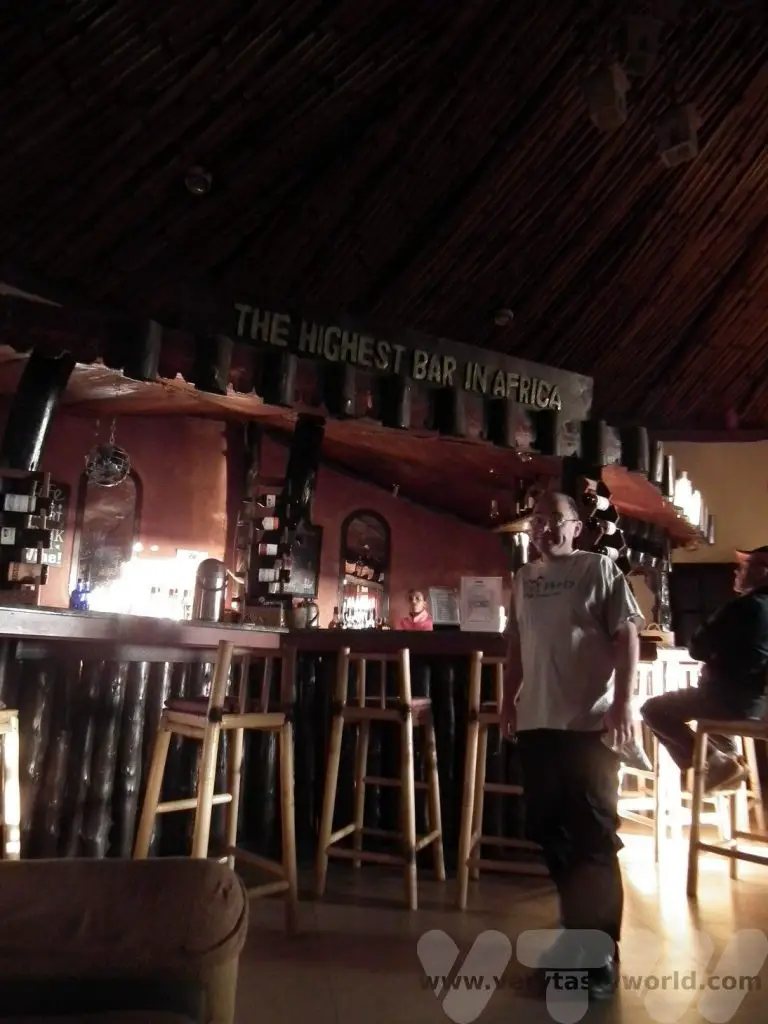
The lodge also claims to have the highest bar in Africa, so we made sure to enjoy post-exploration beers in the evenings.
Monkey Magic
On our first day we enjoyed hiking in the area. The landscapes are spectacularly beautiful. Walking through fields scented with wild thyme we encountered groups of gelada monkeys, which are also known as gelada baboons, bleeding-heart baboons, or lion monkeys. They are found only in the Ethiopian highlands. They look like baboons but are monkeys and are characterised by their long, shaggy golden coats, which look like lions’ manes, and a heart-shaped patch of pink bare skin on their chests.
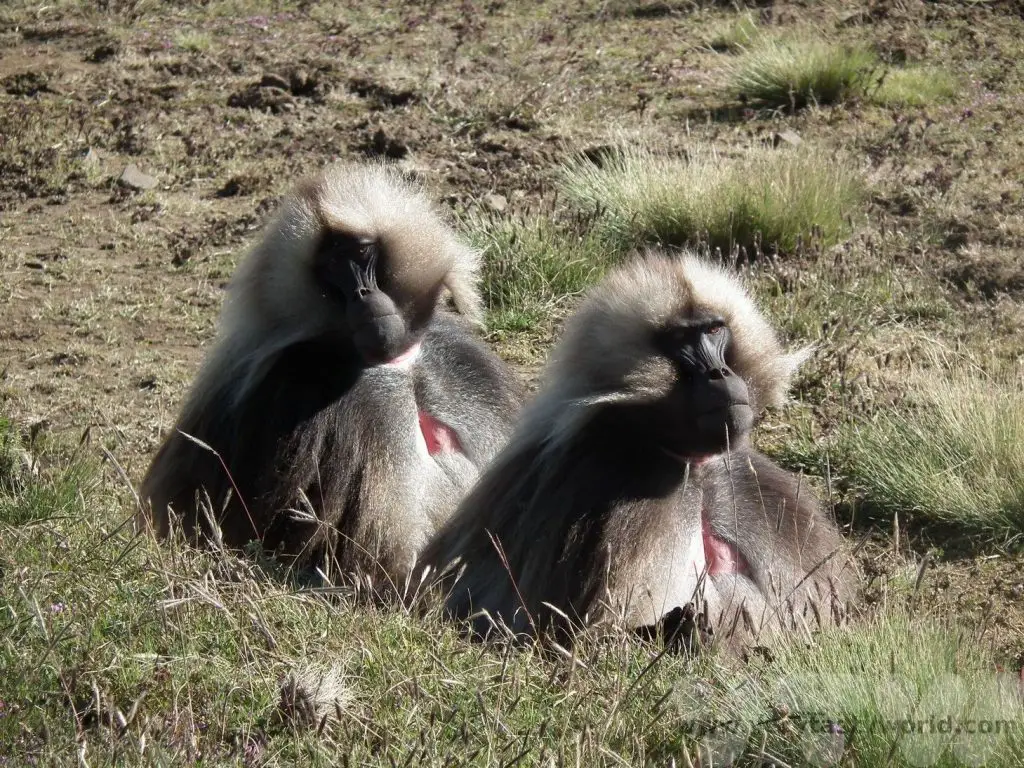
The gelada spend much of their time foraging for grass or herbs in the grasslands but sleep on the ledges of nearby cliffs at night, in order to avoid predators such as servals and leopards as well as domestic dogs.
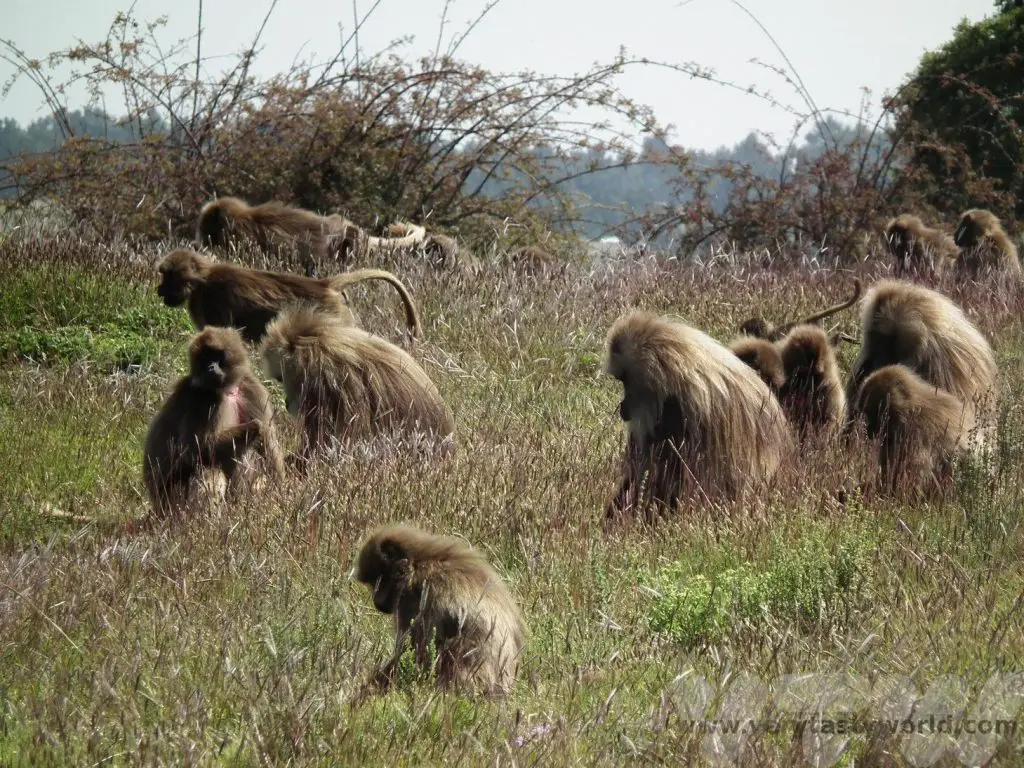
They have a complex society and the different groups move together as troupe through the day.
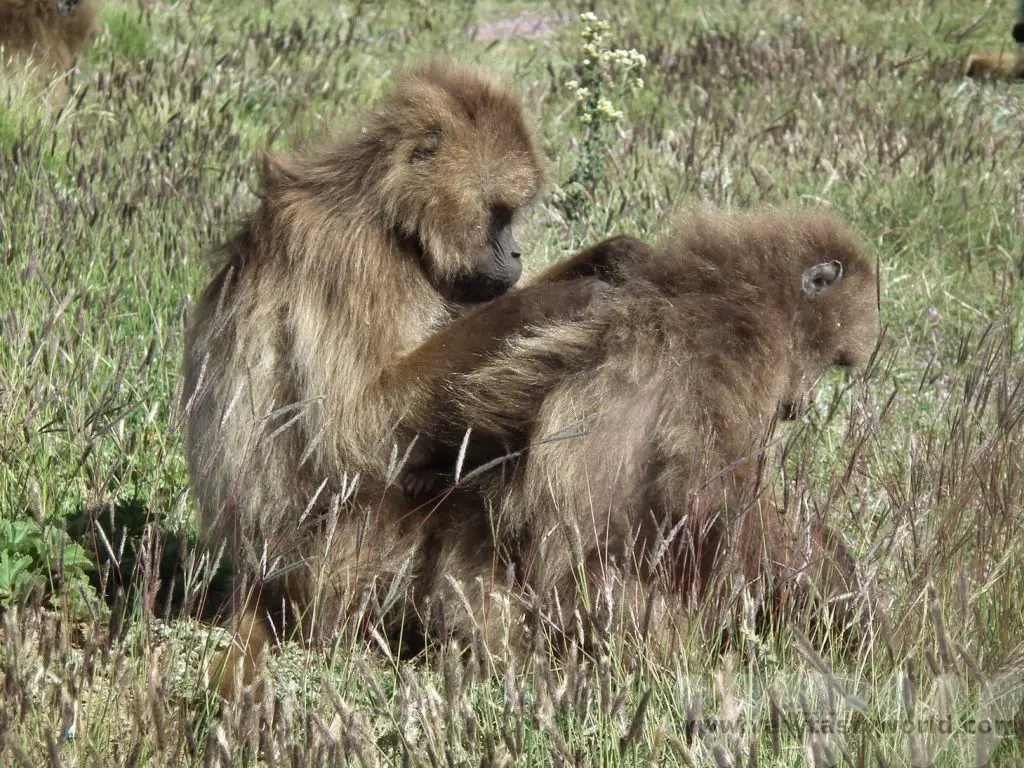
We met researchers who were monitoring the monkeys andobserving their behaviour. They had spent some time recording the social dynamics between the groups as well as monitoring diseases.
Unlike baboons, the gelada have a very gentle nature (at least with human visitors – we did see some play-fighting and chasing each other!). They are quite relaxed about people walking among them. Obviously we had to treat them with respect and keep a reasonable distance, but it was an absolute joy to be able to get so close to these wonderful creatures.
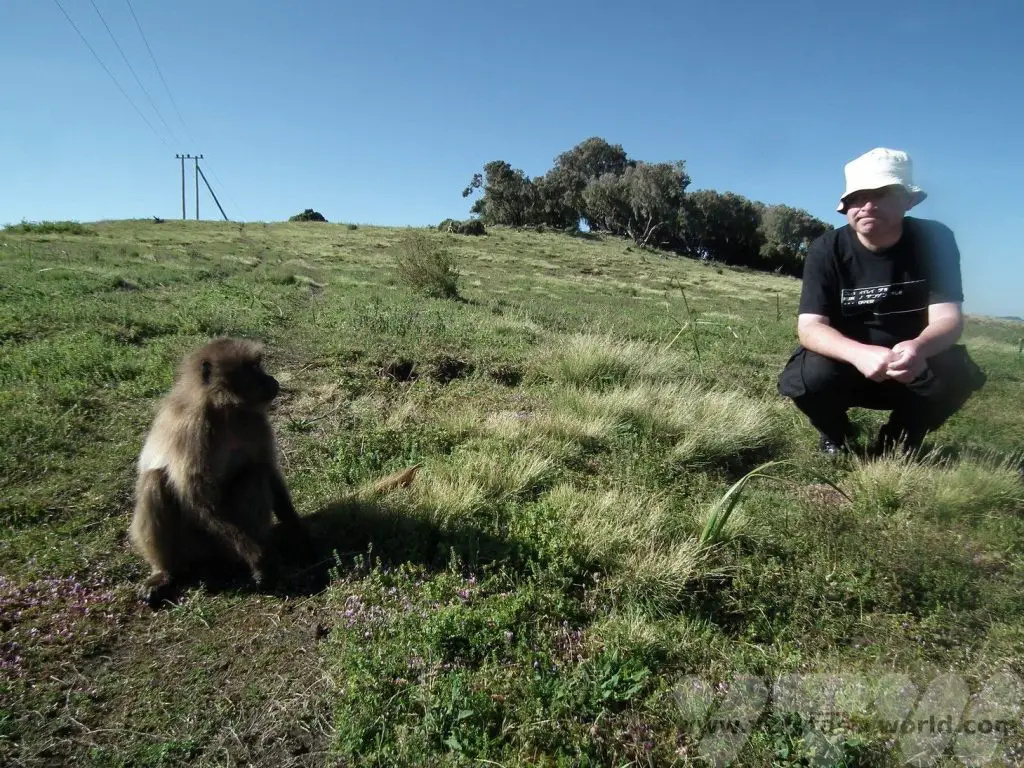
The baby monkeys were having such a fun time in the trees!
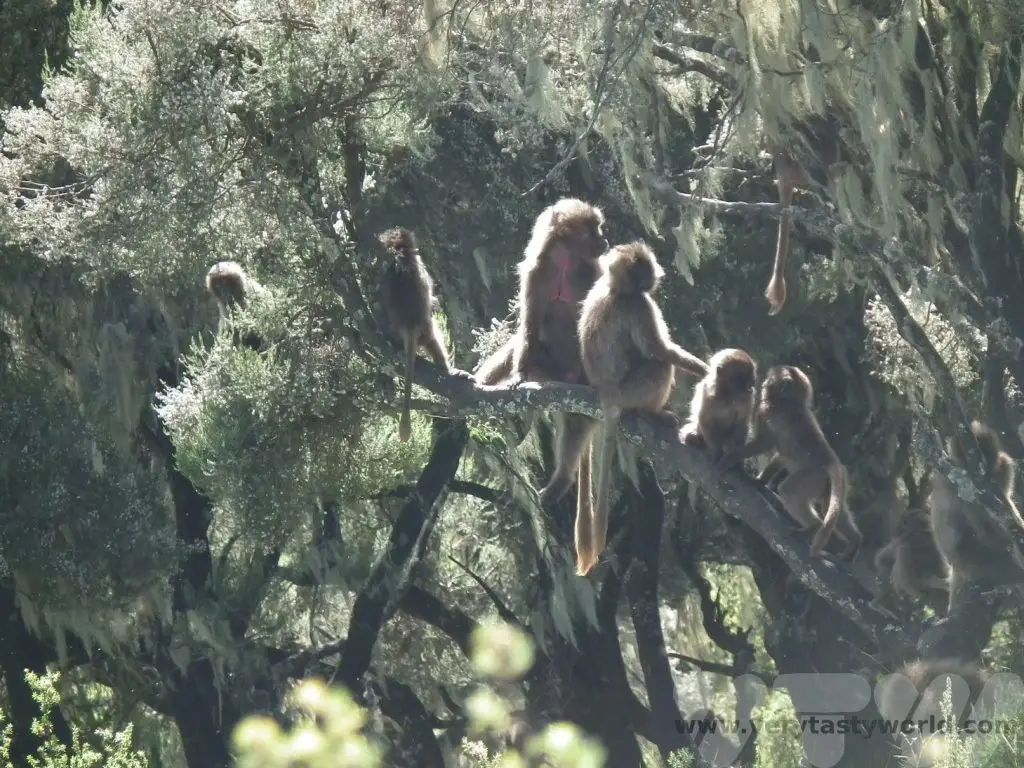
Viewing Spectacular Views
The following day we visited Chenek to see the Kurbet Metaya viewpoint, a wonderful vista overlooking the mountains. The viewpoint is actually a gap in the cliffs revealing views of the mountain faces and a beautiful valley.
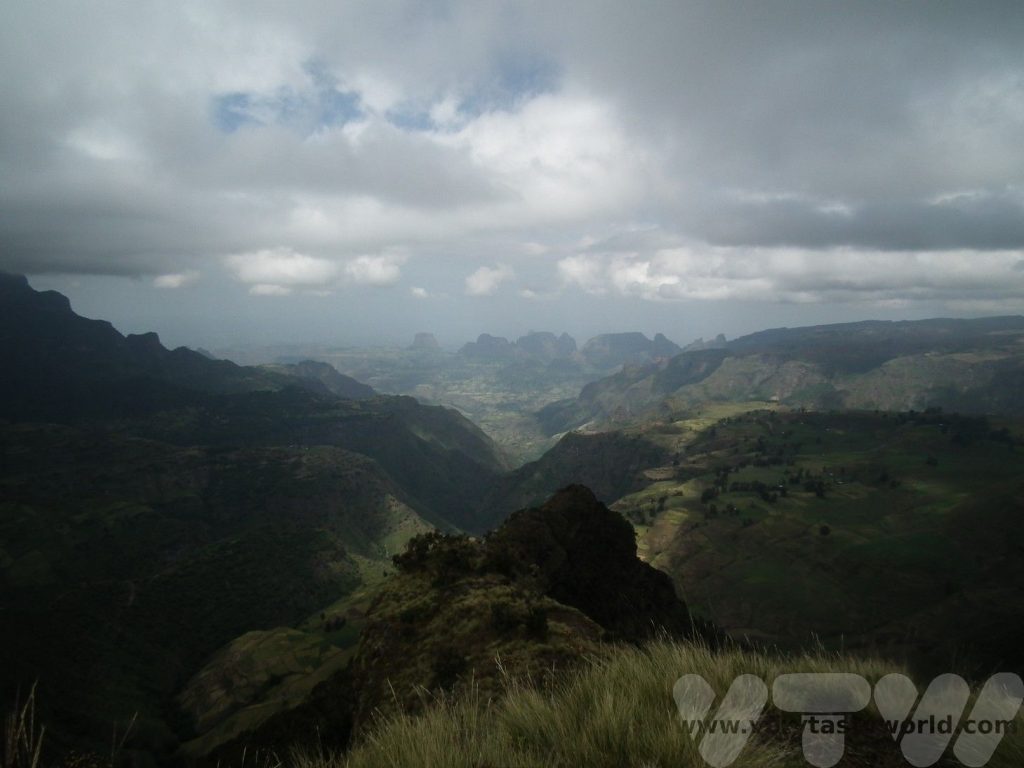
We continued to explore more of the area. As ever, it’s always worth looking out for other travellers pointing at something in the distance. In this case it was a rare and endangered Walia Ibex, found only in these mountains. It was actually quite some distance away at the foot of a cliff – this was the camera’s best possible zoom picture!
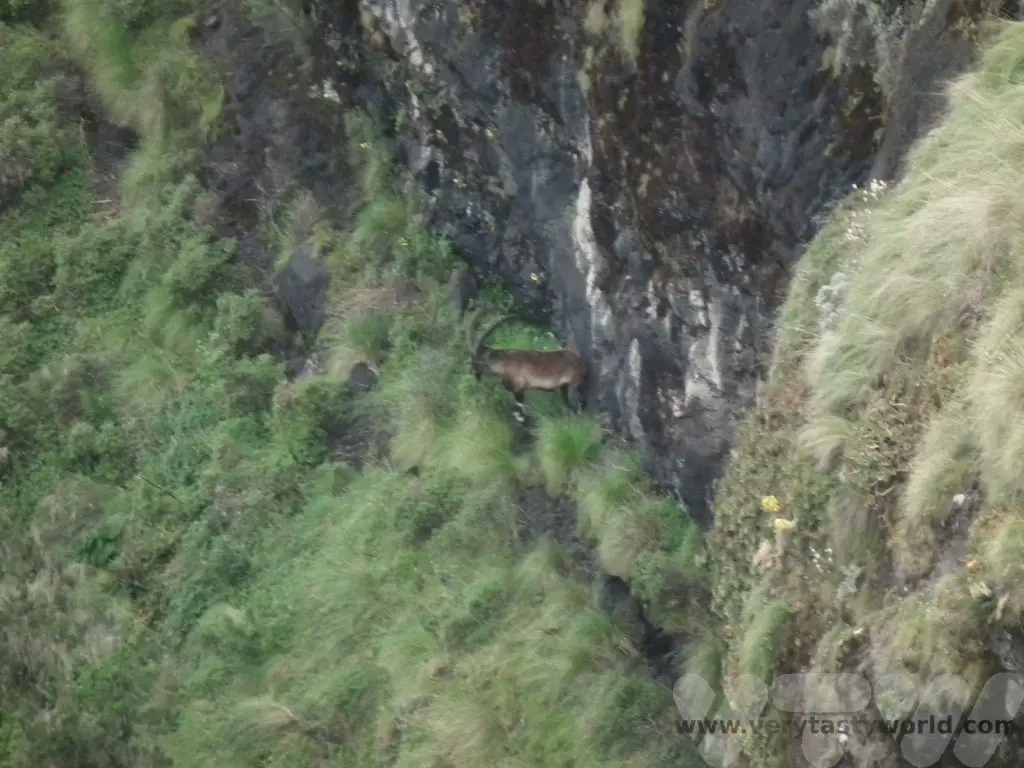
Then we returned to Gondar for one more night at the Jantekel hotel before we caught our flight to Lalibela. The hotel served traditional Ethiopian meals in enormous portions! This is injera, a bread made from teff flour, filled with doro wat, a spicy chicken stew. Injera doesn’t look particularly appetising but it tastes great. It’s fermented and has a lovely sour flavour.
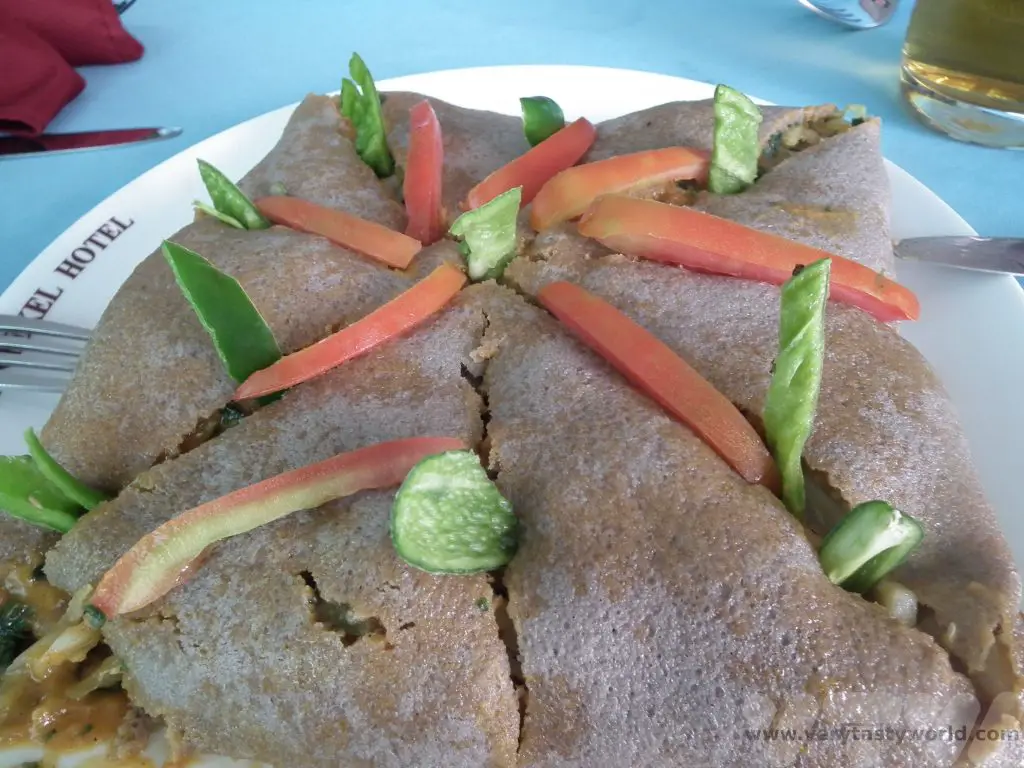


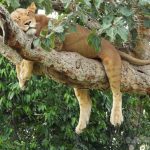

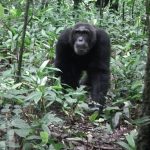
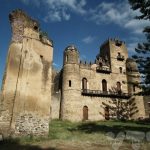



Fasilides’ castle looks right up my street, it would be one of those places to visit without he dog for me.
It was a fantastic castle to visit and lovely that we were able to explore all the buildings in the area. Yes, probably difficult to bring Henry!
I agree with RJ, this was a lovely castle and baths to explore, thanks for sharing! The baths taken over by the trees reminded me of Cambodia. Who would have know that Ethiopian history had so much drama and intrigues going on?
Carolin | Solo Travel Story
Thank you for your comment! You’re absolutely right about the trees – they reminded us of Cambodia as well. And we didn’t realise what a fascinating – and dramatic – history Ethiopia had!
What a fascinating trip. I love the frescoes in the church especially the cherubs in the ceiling. And the monkeys too of course!! 🐵
Thank you! Yes, it was fascinating, particularly the history, which we didn’t know much about before our visit. We saw a lot of frescoes in the churches – they were all so distinctive. We just adored the Simien mountains – walking with the gelada monkeys was magical.
I had never considered Ethiopia as a destination, but it looks fascinating with a rich and varied history. Looks like you found some good accommodation options. Was this a guided tour or self-guided? I am intrigued!
Ethiopia is a wonderful destination – it has so much to offer. It has a history going back thousands of years and the most remarkable architectural sites as well as fantastic opportunities to see wildlife. We loved our time there. We found an excellent local tour operator who was able to arrange a trip for us covering much of northern Ethiopia.
What an enriching trip this must be for u both☺️ Fascinating pics as well as the choice of travel destination. I used to work closely with the country’s national carrier but never made it to Ethiopia. Thanks for reigniting an old dream #flyingbaguette
Such a fascinating description of everything. Love the history lesson as it brings the buildings to life as to why they sre here. Those castles are certainly very European in style and such a contrast with the traditional local buildings. Love the story of the strong Queen putting the nobles in their place.
I wanted to go to Ethiopia but the civil war has delayed my plans. Hope I can get there soon.
Yes, the history really is fascinating – we learned so much on our visit. We were really pleased to hear that a peace treaty has recently been signed so we are hoping that it won’t be long before Ethiopia can welcome tourists again. We are sure you will enjoy a visit.
Thank you – it was indeed an absolutely wonderful trip. Ethiopia has so much history and the wildlife is amazing. Do hope you get a chance to visit one day, we are sure you will love it.
Such an interesting place with lots of history. It – and reading similar things – makes me wish I knew more about African history. I had a class in college that introduced some of it, and it really is fascinating. That castle is very impressive. It almost looks like more like our traditional idea of a medieval castle than some actual medieval castles in Europe.
You’re absolutely right about the mediaeval castles looking like the traditional vision of a castle with the crenellations on the battlements. Ethiopia has a history that is long and rich, it really was fascinating learning about it.
The ibex and gelada look so neat. What fabulous snaps too. This region of Ethiopia looks far different than anything I have seen via the media; typical, LOL. Excellent blog post.
Thank you so much! Ethiopia really has so much to offer – history, wildlife, spectacular landscape. Our perceptions of the country changed totally after our visit.